Navigate the intriguing world of Qedar in the Bible, where ancient tales of nomadic tribes and prophetic encounters reveal a hidden past.
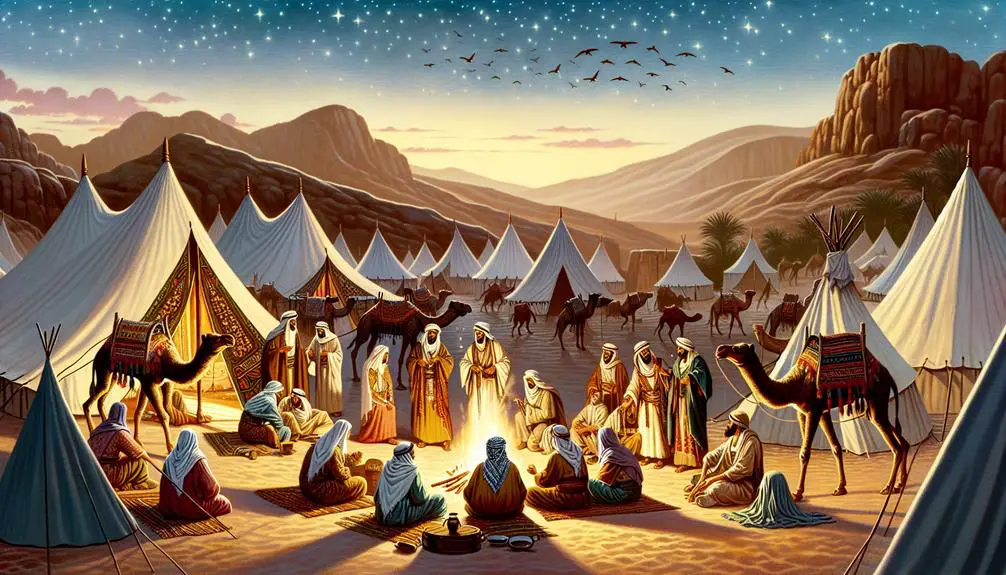
Qedar in the Bible
Diving into the biblical narrative of Qedar is akin to unearthing a time capsule, offering a glimpse into a world that once thrived at the crossroads of ancient civilizations.
You'll find that Qedar, a nomadic tribe descended from Ishmael, occupies a unique space in biblical history, weaving through stories of trade, conflict, and prophecy.
Their lifestyle, economic activities, and interactions with Israel paint a complex picture of ancient Middle Eastern dynamics.
As you explore the layers of Qedar's legacy, you'll uncover how their story intersects with broader biblical themes, leaving you wondering about the echoes of their influence in today's world.
Key Takeaways
- Qedar's link to Ishmael's second son signifies its biblical ancestry and historical relevance.
- Located in the northwestern Arabian Peninsula, Qedar connected key ancient trade routes, enhancing its significance in biblical narratives.
- Qedar's nomadic traditions and social structure likely influenced the depiction of its people in biblical contexts.
- Military prowess and trading practices of the Qedarites played crucial roles in their interactions with neighboring biblical figures and nations.
Origins of Qedar

The origins of Qedar trace back to the ancient Semitic tribes, as it's traditionally identified with the second son of Ishmael, offering a profound insight into the historical and cultural fabric of the Near East. This connection not only highlights a significant genealogical lineage but also situates Qedar within a specific geographical location, enriching our understanding of the region's dynamics during ancient times. You'll find that the geographical location of Qedar is crucial for grasping the full scope of its historical significance. Positioned in what's now the northwestern part of the Arabian Peninsula, this area was a nexus of various trade routes, influencing the socio-economic and political landscapes of the Near East.
The historical accuracy of Qedar's origins, while rooted in biblical narratives, is corroborated by external sources, including Assyrian and Babylonian inscriptions. These records not only affirm the existence of Qedar but also provide additional context regarding its role and influence in the region. This cross-referencing of sources is vital for constructing a well-rounded historical account, allowing you to appreciate the complexities and nuances of ancient Near Eastern history.
Understanding the origins of Qedar, therefore, isn't just about tracing lineage or pinpointing a location on a map. It's about delving into the interwoven layers of history, culture, and geography that define the Near East. As you explore these dimensions, you're engaging with a narrative that's both ancient and enduring, offering insights into how the past shapes our understanding of the present.
Qedar's Descendants
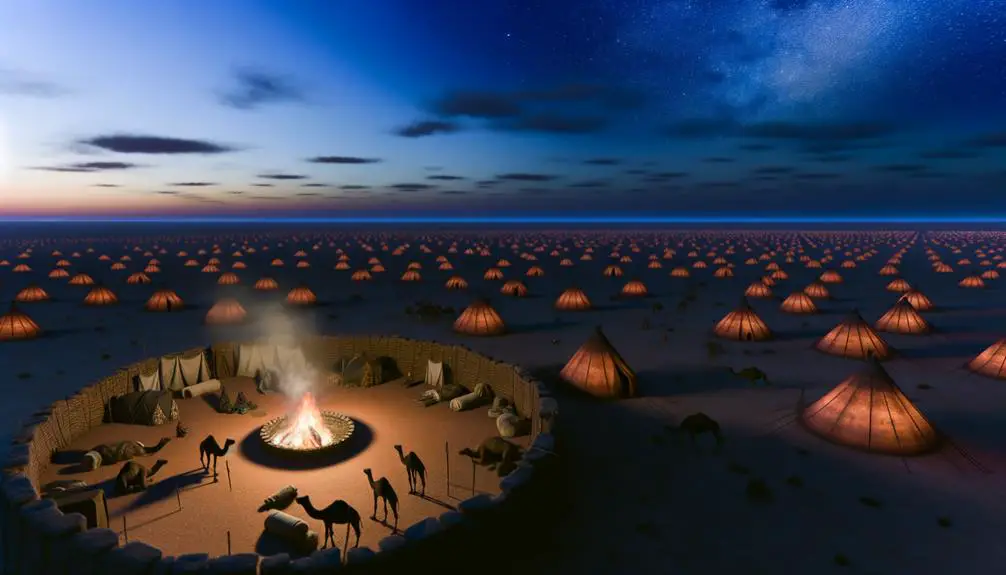
Delving into the lineage of Qedar, you'll uncover a complex network of descendants that played pivotal roles in the unfolding narrative of the Near East's history. Qedar's lineage, deeply rooted in the annals of ancient texts, has sparked considerable genealogical debates among scholars. The descendants of Qedar, as mentioned in various historical and religious documents, offer a fascinating glimpse into the lineage's influence across generations.
To draw you further into the significance of Qedar's lineage, consider the following key points:
- Prominence in Tribal Confederations: Qedar's descendants are often identified as leading various tribal confederations, which wielded significant power in the Arabian Peninsula. Their leadership roles underscore the lineage's political and military influence in the region.
- Alliances and Conflicts: Historical records highlight the complex web of alliances and conflicts involving Qedar's descendants. These narratives showcase the strategic importance of maintaining familial ties and the repercussions of rivalries that shaped the geopolitical landscape.
- Genealogical Debates: Scholars have engaged in rigorous debates over the accuracy and interpretation of Qedar's genealogy. The discussions revolve around the lineage's connections to other notable figures and tribes, challenging the traditional understanding of Near Eastern genealogies.
- Cultural and Religious Impact: The descendants of Qedar played pivotal roles in the cultural and religious developments of their time. Their influence extended beyond mere political power, contributing to the spiritual and societal evolutions of the region.
As you delve deeper into Qedar's lineage, you'll appreciate the complexity and significance of these descendants in shaping the course of Near Eastern history.
Lifestyle and Culture
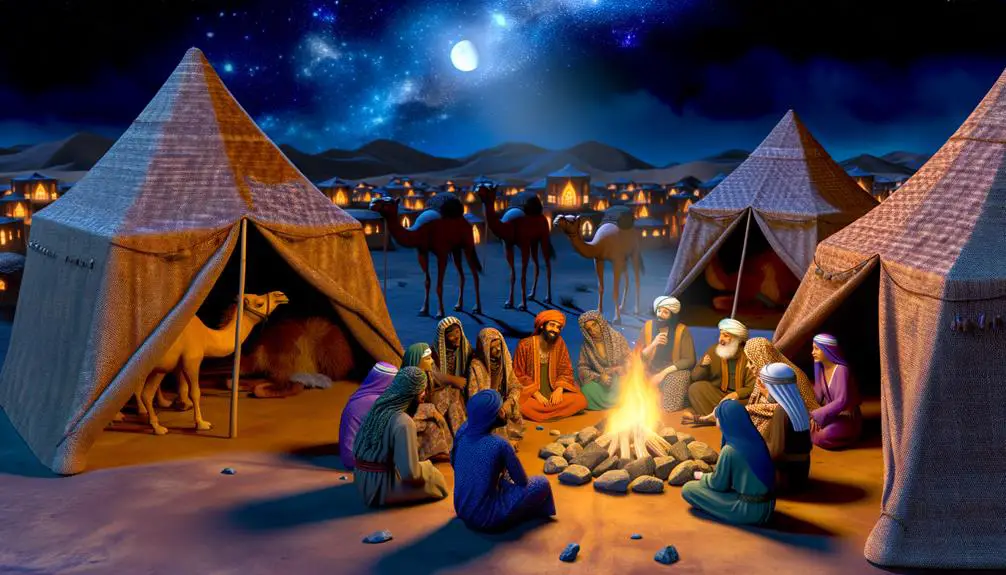
As you explore the lifestyle and culture of Qedar, you'll find that nomadic traditions deeply influenced their social structure and religious practices.
These elements were interwoven, shaping a society that was both mobile and deeply spiritual.
Understanding these aspects provides critical insight into how the Qedarites navigated their existence and interacted with neighboring cultures.
Nomadic Traditions
Within the context of Qedar in the Bible, understanding the nomadic traditions, notably their lifestyle and culture, requires an appreciation of how these ancient people adapted to their environment to ensure survival and continuity. Here are key aspects to consider:
- Desert navigation: Mastery over navigating the vast, featureless deserts was crucial. They developed sophisticated techniques to guide them across these arid landscapes.
- Seasonal migrations: Their movements were dictated by the seasons, moving to areas where water and pasture were accessible.
- Tent dwellings: Their homes were portable, allowing quick assembly and disassembly, facilitating their nomadic lifestyle.
- Herding practices: Livestock, especially camels and goats, were central to their economy, providing food, clothing, and trade goods.
These elements underline the adaptive strategies that defined their existence in a challenging environment.
Social Structure
Building on the understanding of nomadic traditions, it's critical to explore the social structure of the Qedarites to fully grasp their lifestyle and culture. At the heart of their society was a complex tribal hierarchy, which wasn't just a framework for their community but shaped their daily lives and interactions.
Leadership roles were paramount, often inherited within families, indicating a deeply rooted respect for lineage and blood ties. These leaders didn't just govern; they were custodians of cultural norms, arbiters in disputes, and guardians of their people's welfare. This structure ensured a cohesive unit, vital for survival and prosperity in the harsh desert environment.
The Qedarites' social fabric, woven through with these hierarchies and roles, was fundamental to their identity, influencing every aspect of their communal and individual existence.
Religious Practices
The religious practices of the Qedarites, deeply interwoven into their lifestyle and culture, offer a window into their spiritual life and societal values. Analyzing these practices reveals:
- Sacred Rituals: Central to their divine worship, these rituals connected community members to each other and the divine, reinforcing social bonds.
- Pilgrimages: Undertaken to sacred sites, these journeys were both a spiritual quest and a communal activity, highlighting the importance of physical spaces in their worship.
- Offerings and Sacrifices: Essential for appeasing deities, these practices underscored the Qedarites' belief in a reciprocal relationship with the divine.
- Oracles and Divination: Sought for guidance, these practices reflected a world where the divine influenced daily decisions and the future was actively interpreted through sacred means.
Military Prowess
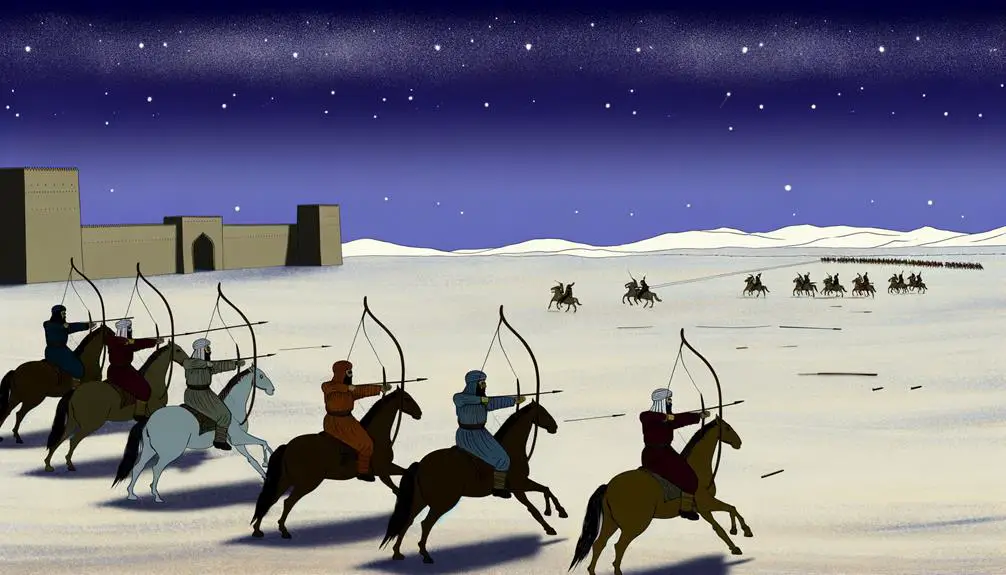
Renowned for their military prowess, the Qedarites were formidable adversaries in ancient Near Eastern conflicts. Their battle tactics and warfare strategies set them apart in a region where martial skill often determined a nation's survival and prosperity. As you delve into the historical accounts, you'll find that the Qedarites' approach to warfare wasn't merely about brute strength; it was deeply strategic, leveraging their knowledge of the terrain and innovative tactics to outmaneuver more numerous foes.
Their warfare strategies were diverse, reflecting a deep understanding of the complexities of combat. The Qedarites excelled in guerrilla tactics, using the vast deserts as their ally to launch surprise attacks and swiftly disappear without a trace. This hit-and-run technique frustrated their enemies, who often found themselves fighting shadows on unfamiliar ground. Moreover, the Qedarites' battle tactics were flexible, allowing them to adapt quickly to the changing dynamics of the battlefield. Whether facing a direct assault or a prolonged siege, they demonstrated remarkable resilience and ingenuity.
In analyzing their military prowess, it's clear that the Qedarites' success in battle wasn't solely due to their physical might but also their sharp minds. They understood the value of intelligence gathering, using scouts to monitor enemy movements and communications. This emphasis on knowledge and preparation ensured they were always several steps ahead of their adversaries.
Their legacy in military history serves as a testament to their skill and strategic acumen. The Qedarites' contributions to ancient warfare strategies continue to be studied and admired for their complexity, effectiveness, and the fear they instilled in their enemies.
Economic Activities
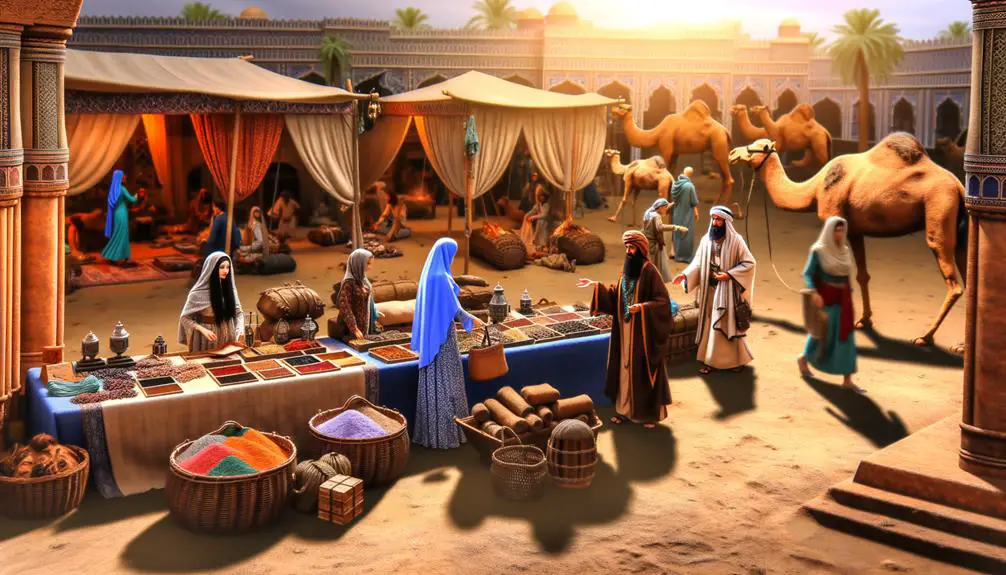
You'll find that the economic backbone of Qedar was significantly supported by their trading practices and livestock management.
These activities not only sustained their community but also facilitated interactions with neighboring regions, enhancing their economic and social networks.
Analyzing these practices offers insight into the sophistication of Qedar's economy and its integration into the broader ancient Near Eastern economic landscape.
Trading Practices
Qedar's economic activities prominently included trading practices that were integral to their societal structure and wealth accumulation. In the context of the ancient Near East, the Qedarites played a crucial role in the development of commerce through:
- Establishment of Caravan Routes: They strategically utilized and maintained caravan routes that facilitated trade across vast deserts, connecting various civilizations.
- Marketplaces Development: By establishing marketplaces, they not only traded goods but also ideas and cultures, enriching their society.
- Trade in Exotic Goods: Their position allowed them access to luxury items from distant lands, which they traded for local products.
- Diplomatic Relations: Through trade, they forged diplomatic relations with neighboring states, securing their economic interests and expanding their influence.
This multifaceted approach to trade underscored their economic acumen and contributed to their enduring legacy.
Livestock Management
Building on their trading practices, the Qedarites also excelled in livestock management, a cornerstone of their economic activities that further solidified their prosperity. You'll find their expertise was not just in breeding but also in understanding and optimizing grazing patterns and genetic selection. This strategic approach ensured robust herds capable of thriving in the harsh desert environment.
Aspect |
Description |
|---|---|
Grazing Patterns |
Meticulously planned to prevent overuse of any single area, ensuring sustainable fodder for herds. |
Genetic Selection |
Focused on traits like resilience and endurance, enhancing the livestock's ability to thrive. |
Economic Impact |
Livestock was a primary wealth indicator, bolstering trade and social status. |
Sustainability |
Practices ensured long-term viability of herding as a profession. |
Innovation |
Continual improvement of breeding techniques, showcasing their forward-thinking approach. |
Their methods were ahead of their time, blending tradition with innovation, a testament to their ingenuity and adaptability.
Prophetic References

Several biblical prophecies reference Qedar, highlighting its significant role in the theological and historical narrative of the text. The mention of Qedar in prophetic contexts often revolves around its eschatological roles and divine judgments, marking it as a noteworthy entity within the biblical worldview.
Here's an analytical look at the prophetic references to Qedar:
- Isaiah's Oracles: Isaiah's prophecies about Qedar are rich in eschatological significance. They portray a future where Qedar's warriors, known for their archery, face divine judgment. This reflects a broader theme of divine sovereignty and judgment upon nations.
- Jeremiah's Predictions: Jeremiah speaks of Qedar in the context of divine judgments against various nations. His prophecies suggest a downfall for Qedar due to its people's practices and disobedience, aligning with the broader narrative of accountability before God.
- Ezekiel's Visions: In Ezekiel, Qedar is mentioned among nations destined for judgment. This emphasizes the theme of universal justice, where even distant or seemingly insignificant communities like Qedar are subject to divine scrutiny.
- Psalms and Song of Solomon: Though not strictly prophetic, these books reference Qedar in a manner that complements the prophetic narrative. The beauty of Qedar's inhabitants and their tents in Song of Solomon contrasts with the harsh divine judgments predicted in the prophets, highlighting the complexity of Qedar's portrayal in Scripture.
This analysis underscores Qedar's multifaceted role within biblical prophecy, serving as a symbol of both divine judgment and the eschatological realities facing all nations.
Interactions With Israel
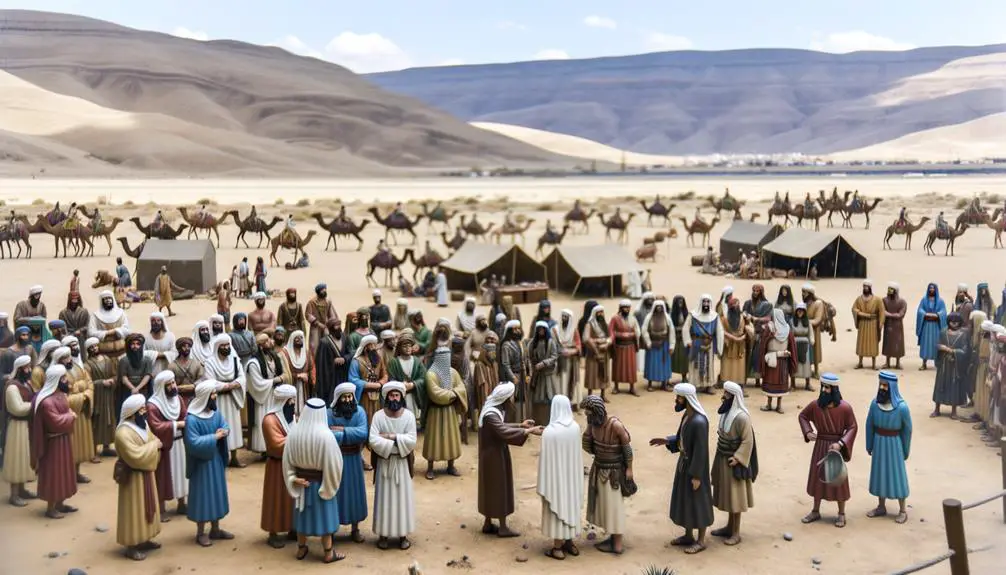
Throughout the biblical narrative, the interactions between Israel and Qedar reveal a complex web of political, social, and theological dynamics, shaping the historical and prophetic contexts of both entities. You'll find that Qedar's alliances play a significant role in this intricate relationship. These alliances, often formed through strategic marriages and political agreements, served not only to secure peace and mutual benefits but also to weave the fabric of regional geopolitics. Such arrangements were common in the ancient Near East, reflecting a pragmatic approach to diplomacy and survival.
Delving deeper, you'll notice that Israelite marriages with the Qedarites highlight a fascinating aspect of these interactions. These unions, sometimes controversial, weren't merely personal or familial decisions but carried profound implications for national identity, religious practices, and social integration. They underscore the interconnectedness of the peoples in the region and the sometimes porous boundaries between distinct ethnic and religious groups.
Analyzing these marriages and alliances, it becomes evident that they facilitated cultural exchanges and influenced religious practices, contributing to a dynamic interchange of ideas, beliefs, and traditions. This cross-pollination enriched both societies, although it also posed challenges to maintaining religious purity and cultural distinctiveness, themes that are recurrent in the prophetic literature addressing Israel's relations with its neighbors, including Qedar.
In essence, the interactions between Israel and Qedar encapsulate a multifaceted relationship characterized by political maneuvering, social intermingling, and theological entanglements. These dynamics not only illuminate the historical realities of the ancient Near East but also offer insights into the complexities of intercultural relations and their enduring impact.
Qedar's Legacy
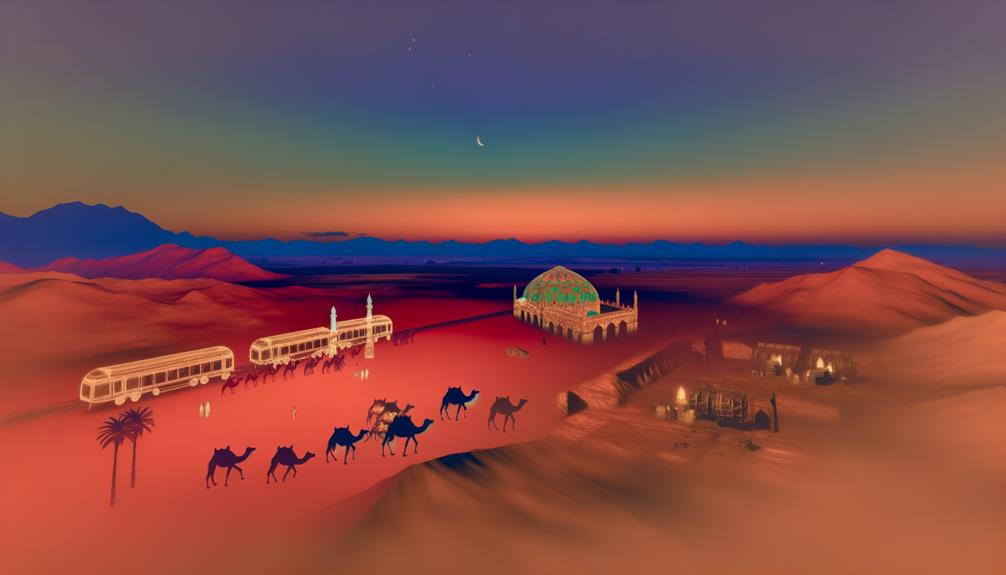
Qedar's legacy, deeply embedded in the annals of history, continues to shape our understanding of ancient Near Eastern societies and their intricate interrelations. This legacy is multifaceted, encompassing the geographical significance and archaeological findings that offer insights into this ancient nomadic tribe. Here's how Qedar's historical footprint enlightens us:
- Geographical Significance: The Qedarites occupied a strategic location that connected various ancient trade routes. Their territory served as a bridge between the civilizations of Mesopotamia, the Arabian Peninsula, and the Levant. This position not only facilitated trade but also cultural exchanges, making Qedar a melting pot of ancient Near Eastern society.
- Archaeological Findings: Excavations in regions historically associated with Qedar have uncovered artefacts that testify to their way of life, social structure, and economic activities. These findings include inscriptions that shed light on their language, religious practices, and interactions with neighboring states.
- Influence on Regional Politics: Qedar's alliances and conflicts with surrounding nations significantly influenced the political landscape of the Near East. Their engagements with powerful empires like Babylon and Assyria reveal a nuanced understanding of diplomacy and survival in a volatile region.
- Cultural Contributions: Beyond their political and economic influence, the Qedarites contributed to the cultural and intellectual tapestry of the ancient Near East. Their stories, preserved in biblical texts and other ancient literature, continue to offer a unique perspective on the era's worldview.
Through these lenses, you're invited to delve deeper into the intricate legacy of Qedar, which remains a critical chapter in our exploration of ancient civilizations.
Frequently Asked Questions
How Has Modern Archaeology Contributed to Our Understanding of Qedar Outside of Biblical Texts?
Modern archaeology has significantly expanded our understanding of Qedar through detailed inscription analysis and examination of ancient trade routes. By studying inscriptions found in the Arabian Peninsula, we gain insights into the social, political, and economic aspects of their society. Analyzing trade routes has revealed the extensive connections and influence Qedar had in the region. This archaeological evidence provides a broader context to Qedar's historical significance, beyond biblical references.
What Are the Linguistic Similarities and Differences Between the Language of Qedar and Classical Arabic?
You're barking up the right tree if you're curious about the linguistic ties between Qedar's language and classical Arabic. They share a rich tapestry of linguistic evolution, yet there are script variations that set them apart.
Diving into this analysis, you'll find that while the core vocabulary and grammatical structures show a strong lineage, the writing systems reflect a journey from ancient inscriptions to the more uniform script of classical Arabic.
How Have Interpretations of Qedar's Role in Biblical Narratives Evolved in Various Religious Traditions Over the Centuries?
You'll find that interpretations of Qedar's spirituality have transformed significantly across religious traditions over centuries.
Early views often centered on its exoticism, evolving with deeper interfaith interpretations that highlight shared spiritual legacies.
Scholars now analyze these narratives to uncover nuanced understandings of faith interactions. This shift reflects a broader move towards appreciating the interconnectedness of ancient spiritual traditions, offering a richer, more inclusive perspective on Qedar's role in historical religious dialogues.
Can Any Direct Lineage or Genetic Links Be Established Between the People of Qedar and Contemporary Middle Eastern Populations?
You're delving into whether modern Middle Eastern populations can trace their roots back to the people of Qedar through genetic links. By employing genetic testing methodologies, researchers aim to uncover these connections.
However, the mobility fostered by ancient trade routes complicates this quest. These routes facilitated a blend of cultures and genes, making it challenging to pinpoint direct lineage.
Your inquiry intersects with broader studies on human migration and ancestry.
How Do Contemporary Scholars Reconcile Discrepancies Between Historical Records and Biblical Accounts Regarding the Kingdom of Qedar?
When tackling discrepancies between historical records and biblical narratives about the kingdom of Qedar, contemporary scholars often employ textual criticism.
You'll find they meticulously analyze ancient texts, comparing biblical accounts with archaeological findings and other historical documents.
This rigorous approach allows them to differentiate historical facts from mythological integration. By doing so, they aim to provide a more accurate and contextual understanding of Qedar's place in history.
Conclusion
In your exploration of Qedar's saga, you've traversed the sands of time, uncovering a legacy more enduring than the desert's oldest dunes. You've seen how their military might, economic savvy, and prophetic significance intertwined with Israel, shaping a narrative rich with cultural and historical nuances.
Through scholarly lenses, you've discerned Qedar's monumental impact on biblical narratives, an influence echoing across millennia. Truly, Qedar's story isn't just a chapter in history; it's a testament to the indomitable spirit of humanity.



Sign up